

Stay in West Loop or Wicker Park to be within walking distance of galleries, fashionable stores, and some of the city’s best restaurants.

Base yourself in the River North area to easily get to most major sites and museums on foot. Within neighborhoods, Chicago is a walkable city. Take extra care in, or passing through, the Austin, Englewood, North Lawndale, or West Garfield Park neighborhoods, but most of the city is safe. Homicides are concentrated to the south and west sides of the city, where they went up in 2018. In fact, the murder rate dropped in 2018 for the second year in a row. It does have high rates of gun deaths, but the city is not even in the top 25 for cities with the highest murder rates in the United States. Chicago is often called one of the murder capitals of America. Use common sense when traveling around the city, but also understand that the reasons some areas are more dangerous is complicated. Segregation and isolation have exacerbated inequality and contributed to violence. Also, middle-class black families are leaving-181,000 black residents left Chicago between 20. Industrial jobs have disappeared, and access to higher education is poor. A legacy of segregation has shut poor black families out for generations, and it’s still happening as city officials move money away from poor communities. Northwestern University did a study on crime in Chicago and found that 50 percent of shootings were concentrated in 12 poorer neighborhoods, and attributed to gang violence. More than one-third of city workers make more than $100,000 per year, while the city’s median income for a household is $63,153. The unemployment rate is only 3.8 percent, but wealth is not equally distributed. Photo by: Rebecca Hollandīe informed… Chicago is segregated by both wealth and race.

Oak Street Beach on North Lake Shore drive in the winter, with an icy Lake Michigan. Early June or early September are the best times to visit to avoid the mid-summer visitor crush. Millennium Park hosts outdoor movies, concerts, and workouts, neighborhoods have festivals, the beaches are open, and you can rent kayaks, paddle boards, and sailboats. The summer is hot and sunny, restaurants and bars have patios, the Riverwalk is packed with things to do-such as visiting the floating garden, cooling off in Centennial Fountain, or drinking on the steps outside City Winery. Visiting in winter gives you a glimpse of what it means to live here and love it, wind chill and all. You’ll also have the museums to yourself and restaurants reservations are easier to get. You can ice skate at Millennium or Maggie Daley Park, get drinks in an igloo on the Riverwalk, or hole up in a bar-many have cozy with fireplaces and warm winter drinks. That said, in the Loop (the historic downtown area) you can also use the underground Pedway system to get around. A lot of Chicago is best seen on foot-don’t miss out because you didn’t dress warmly. If you’re visiting in the winter or even early spring, don’t underestimate the cold or biting winds. Chicago gets extremely hot and extremely cold (see recent record-low -50 Fahrenheit wind chills ).
CHICAGO 1930 WALKTHROUGH HOW TO
Here’s how to get around, what’s worth your time and what isn’t, where to feast and drink, and more. It has history and heart, plenty to do and eat, and of course, Midwestern friendliness. The winters may be brutal, but there are still many reasons to visit during that season, and this city pulls you in. The 2019 election of Mayor Lori Lightfoot, Chicago’s first black, female mayor and also Chicago’s first openly gay mayor, signaled a moment of progress in a city tired of the status quo. B ut there’s a feeling of camaraderie and a shared hometown pride that keeps politicians accountable and protestors in the streets. It has its problems - such as historic and enduring segregation, poverty, and high crime rates. We have world-class restaurants, theater, architecture, shopping, parks, and a lake so big it can trick you into thinking you’re on the coast.


 0 kommentar(er)
0 kommentar(er)
